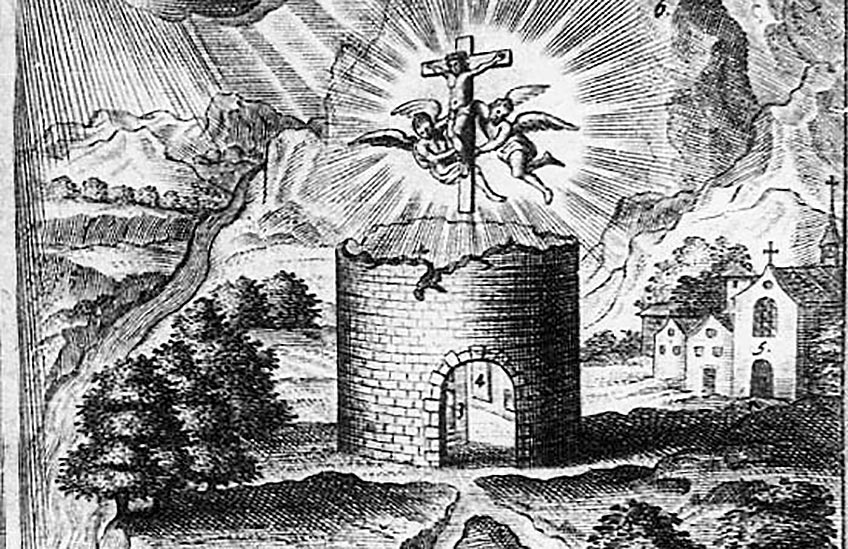A couple of 17th century images of the castle of Javier (I)

PhotoCedit/Loyolaand Javier by Friederik Bouttats (†1676). Javier, Schurhammer Fund, detail.
A number of prints in European collections, depicting St Francis Xavier or the family castle where he was born, provide us with the keys to understanding these images in Europe at the end of the 17th century.
association the houses of Loyola and Javier
An engraving preserved at the Library Services Royal Brussels and photographed by Father Shurhammer, is signed by Friederik Bouttats, probably the Younger, who died in 1676, considered one of the most outstanding in his field official document and author of numerous portraits and illustrations for different publications.
The composition is divided into two parts, left and right, with the two famous Jesuits in the upper part adoring in the name of Jesus - the true emblem of the Society - enveloped in a luminous sun. Regarding this last element, we may recall that Saint Ignatius "saw Christ as the sun, especially when he was dealing with important things" (Autobiography, 99).
On a lower level, we find the famous ancestral tower house of Saint Ignatius, made of stone and brick. Next to it and to the right, there is a representation of what is meant to be an imaginary castle, in the form of a stone tower, demolished in its upper part, above which emerges the miraculous Christ carried by angels, and a little further on, the abbey of Javier, in the form of a small church. Inside the tower there are two rooms, both with a marvellous content, very much in tune with the culture and religiosity of the 17th century.
The first of these is the chapel of the miraculous Christ who, according to tradition, had sweated blood in various circumstances related to the life of the missionary saint. This was a place at reference letter in the castle, where the 15th century Gothic image of the Crucified Christ was venerated, which gained new prominence as a result of the legend that depicted him sweating blood when Javier died and on other occasions, on the occasion of his apostolic exploits.
The other room to be evoked inside the tower is the so-called holy chapel, which is none other than the room in which Saint Francis Xavier was supposed to have been born, where a chapel was built, joining two floors of the new palace, which would soon be known as the holy chapel, and later as the most holy chapel and basilica. In a society captivated by marvellous phenomena and in the presence of a saint who performed unparalleled wonders, people from all walks of life flocked to this emblematic place to apply for and give thanks for all subject of favours.
The transformation of the new palace into a chapel must have taken place around 1619-1620. However, it was not until the second half of the 17th century that it was fitted with a dome and, above all, with a series of Flemish canvases depicting the most significant miracles of the Navarrese saint, the work of Godefrido de Maes (1692).
The number of pilgrims who came to Xavier to visit and venerate the place where the Apostle of the Indies was born grew with the passage of time. In an anonymous work printed in 1699, dedicated to the Elector of Bavaria, an account is given of the singular case of an Indian from Goa, converted by the saint himself, who came to Xavier to venerate the precise place of his birth. The arrival of numerous pilgrims meant that, in 1731, Don Antonio de Idiáquez, Count of Javier, obtained permission to invest a respectable amount of money to build an inn, with plans by the Capuchin tracista and architect Fray Luis de Tafalla.

Loyola and Xavier by Friederik Bouttats (†1676). Xavier, Schurhammer Fund
To find out more
FERNÁNDEZ GRACIA, R., San Francisco Javier Patron Saint of Navarre. Fiesta, religiosidad e iconografía, Pamplona, Government of Navarre, 2006.
FERNÁNDEZ GRACIA, R., El fondo iconográfico del P. Schurhammer. La report de Javier en imágenes, Pamplona, Chair de Patrimonio y Arte Navarro, 2006.
FERNÁNDEZ GRACIA, R., Image and mentality. Los siglos del Barroco y la estampa devocional en Navarra, Madrid, Fundación Ramón Areces, 2017.
TORRES OLLETA, G., Redes iconográficas: San Francisco Javier en la cultura visual del Barroco, Pamplona, University of Navarre - Madrid, Iberoamericana, Frankfurt am Main, Vervuet, 2009
